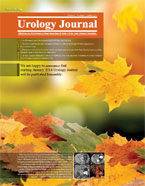The Effect of Urethral Catheter Size on Meatal Stenosis Formation in Children Undergoing Tubularized Incised Plate Urethroplasty
Urology Journal,
Vol. 10 No. 4 (2013),
4 January 2014
,
Page 1095-1098
https://doi.org/10.22037/uj.v10i4.1669
Abstract
Abstract
Purpose: Meatal stenosis is still a common problem in tubularized incised plate urethroplasty.
In this study, we aimed to seek for a relationship between the size of urethral catheter and meatal stenosis formation in children undergoing tubularized incised plate urethroplasty.
Materials and Methods: We retrospectively reviewed 83 children who underwent tubularized incised plate urethroplasty for hypospadias. The whole group was classified into the groups A and B based on the catheter size. One group (group A) consisted of 44 patients (mean age, 4.82 ± 3.83 years) with tubularized neourethra over a 6 Fr catheter, while the other group (group B) included 39 patients (mean age, 5.19 ± 3.83 years) with tubularized neourethra over a 8 Fr catheter.
Results: There were no significant differences between the groups according to their age, location of urethral meatus, dehiscence and urethrocutaneous fistula formation. Meatal stenosis formation in group B was markedly higher than that in group A. Number of meatal dilatation was higher in group B compared to group A.
Conclusion: We suggest that the tubularization of urethral plate over a small-sized (6 Fr) catheter, regardless of the age of the patients, prevents meatal stenosis by reducing foreign body reaction and pressure injury and by hindering secondary healing.
How to Cite
- Abstract Viewed: 403 times
- PDF Downloaded: 273 times
